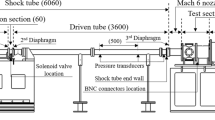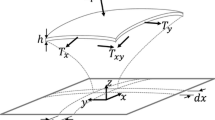Abstract
A novel in-line miniature force transducer is developed for direct measurements of the net aerodynamic forces and moments on a bluff body. The force transducers are integrated into each of the eight mounting wires that are utilized for suspension of an axisymmetric model in a wind tunnel having minimal wake interference. The aerodynamic forces and moments on the model are altered by induced active local attachment of the separated base flow. Fluidic control is effected by an array of four integrated aft-facing synthetic jet actuators that emanate from narrow, azimuthally segmented slots, equally distributed around the perimeter of the circular tail end. The jet orifices are embedded within a small backward-facing step that extends into a Coanda surface. The altered flow dynamics associated with both quasi-steady and transitory asymmetric activation of the flow control effect is characterized by direct force and PIV measurements.















Similar content being viewed by others
Abbreviations
- A j :
-
Actuator orifice cross-sectional area
- C μ :
-
Jet momentum coefficient
- ΔC N :
-
Difference in normal-force coefficient
- D :
-
Axisymmetric body diameter
- R :
-
Axisymmetric body radius
- k :
-
Turbulent kinetic energy
- U :
-
Mean axial velocity component
- V :
-
Mean radial velocity component
- U 0 :
-
Free stream velocity
- U j :
-
Average jet velocity
- T :
-
Jet period
- Re D :
-
Reynolds number
- Re j :
-
Jet Reynolds number
- St D :
-
Strouhal number
- E s :
-
Strain gage readout
- f :
-
Actuation frequency
- t :
-
Time
- ζ :
-
Mean vorticity component
- θ :
-
Temperature
References
Allen D, Smith BL (2009) Axisymmetric Coanda-assisted vectoring. Exp Fluids 46:55–64
Bennett RM, Farmer MG, Mohr RL, Hall WE (1978) Wind-tunnel technique for determining stability derivatives from cable-mounted models. J Aircraft 15(5):304–310
Corke T, Tillotson D, Patel M, Su W, Toldeo W (2008) Radius flow vectoring for plasma drag and steering control using plasma actuators. AIAA-2008-3769
Englar RJ (2000) Circulation control pneumatic aerodynamics: Blown force and moment augmentation and modification - past, present & future. AIAA-2000-2541
Englar RJ (2001) Advanced aerodynamic devices to improve the performance, economics, and handling and safety of heavy vehicles. SAE Technical Paper Series 2001-01-2072
Freund J, Mungal M (1994) Drag and wake modification of axisymmetric bluff bodies using Coanda blowing. J Aircraft 31(3):572–578
Geropp D, Odenthal H-J (2000) Drag reduction of motor vehicles by active flow control using the Coanda effect. Exp Fluids 28:74–85
Hammond D, Redekopp L (1997) Global dynamics and aerodynamic flow vectoring of wakes. J Fluid Mech 338:231–248
Higuchi H, Van Langen P, Sawada H, Tinney CE (2006) Axial flow over a blunt circular cylinder with and without shear layer reattachment. J Fluids Struct 22:949–959
Ho CM, Huerre P (1984) Perturbed free shear layers. Annu Rev Fluid Mech 16:365–422
Kiya M, Mochizuki O, Tamura H, Nozawa T, Ishikawa R, Kushioka K (1990) Turbulence properties of an axisymmetric separation-and-reattaching flow. AIAA J 29(6):936–941
Koenig K, Roshko A (1985) An experimental study of geometrical effects on the drag and flow field of two bluff bodies separated by a gap. J Fluid Mech 156:167–204
Kornilov V (2005) Skin-friction reduction on body of revolution using boundary-layer alteration devices. AIAA J 43(10):2125–2132
Kurn A (1968) Drag measurements on a series of afterbodies at transonic speeds showing the effects of sting interference. Aeronautical research council current papers 984
Lim D, Redekopp L (2002) Aerodynamic flow-vectoring of a planar jet in a co-flowing stream. J Fluid Mech 450:343–375
Magill JC, Wehe SD (2002) Initial test of a wire suspension mount for missile virtual flight testing. AIAA-2002-0169
Magill JC, Cataldi P, Morency JR, Burgess R, Daugherty C, Jeter E (2004) Demonstration of a wire suspension for dynamic wind tunnel testing. AIAA-2004-1296
McMichael J, Lovas A, Plostins P, Sahu J, Brown G, Glezer A (2004) Microadaptive flow control applied to a spinning projectile. AIAA-2004-2512
Newman BG (1961) The deflexion of plane jets by adjacent boundaries-Coanda effect. In: Lachmann GV (ed) Boundary layer and flow control principles and applications, vol 1, Pergamon Press Inc., New York, pp 232–264
Parsons JS, Goodson RE, Goldschmied FR (1974) Shaping of axisymmetric bodies for minimum drag in incompressible flow. J Hydronautics 8(3):100–107
Rao SS (1990) Mechanical vibrations, 2nd edn. Addison-Wesley, New York
Rinehart C, McMichael JM, Glezer A (2003) Transitory flow and force development on a body of revolution using synthetic jet actuation. AIAA-2003-0618
Sigurdson LW (1995) The structure and control of a turbulent reattaching flow. J Fluid Mech 298:139–165
Smith BL, Glezer A (1998) The formation and evolution of synthetic jets. Phys Fluids 10(9):2281–2297
Smith BL, Glezer A (2002) Jet vectoring using synthetic jets. J Fluid Mech 458:1–34
Vukasinovic B, Glezer A (2006) Transitory fluidic control of turbulent shear flows. AIAA-2006-3227
Weickgenannt A, Monkewitz P (2000) Control of vortex shedding in an axisymmetric bluff body wake. Euro J Mech-B/Fluids 19(5):789–812
Wille R, Fernholz H (1965) Report on the first European mechanics colloquium on the Coanda effect. J Fluid Mech 23:801–819
Acknowledgments
This work has been supported by the Army Research Office.
Author information
Authors and Affiliations
Corresponding author
Appendix: model’s natural frequencies
Appendix: model’s natural frequencies
The axisymmetric body suspended in the hoop frame, as described in Sect. 2, can be modeled as a spring-mass system, having a single central mass supported by eight springs, when only a longitudinal vibration component of the support wires is considered. Consequently, such a simplified model does not incorporate support-wire tension as a parameter, since only transverse component of vibration depends on tension. Each of the mounting wires has a longitudinal and a transverse vibration component. If the transverse mode is secondary due to the dominant central mass, the longitudinal vibration is utilized to model each wire as a spring, and that vibration frequency is proportional to the cross-sectional area of the wire and inversely proportional to the attached mass and the wire length (Rao 1990)
where m is the mass, k is the equivalent spring constant, A is the cross-sectional wire area, l is the wire length, and E is Young Modulus of wire. In the present system, each wire is braided bronze that has a cross-sectional area of 1.11 × 10−6 m2, a Young Modulus of 110 Gpa, and a length of 0.33 m. Therefore, the equivalent spring constant is 3.7 × 105 N/m.
The suspended model has a configuration of
under assumption x, y, z ≪ X, Y, Z, where X, Y, Z are the coordinates of the model about the cg, and x, y, z are perturbations in the three axial directions. The end points of the wires, connected to the hoop frame, are assumed to be rigid. During the small motions of suspended model, each of the springs (mounting wires) provides a restoring force (Rao 1990)
where \( \bar{a} = \ddot{x}\,\bar{i} + \ddot{y}\,\bar{j} + \ddot{z}\,\bar{k}, \) and \( \delta_{i} = \delta_{i} \left( {x,y,z,X,Y,Z,l} \right), \) \( \bar{F} \) is the restoring force, \( \bar{a} \) is the model acceleration, m is the mass of the body, and δ is the wire displacement. All the wires are identical (k 1 = k 2 = k i = k) and symmetrical around the central body, having the same angle with respect to the three coordinate axes. Decomposing the forces into the three coordinate axes using geometry yields the following equations,
where \( l = \sqrt {X^{2} + Y^{2} + Z^{2} } \) and u 1, u 2, u 3 are the components of the unit vector, u, along the length of each wire.
Applying a first-order Taylor expansion about (x 0, y 0, z 0),
where \( (x_{0} ,y_{0} ,z_{0} ) = (0,0,0) \), yields the following three equations:
The wires in the assembly of the model (Fig. 1) each have a unit vector of \(\overline{u} = \pm 0.712\overline{i} + \pm 0.496\overline{j} + \pm 0.496\overline{k} \). Using Matlab, the above equations are solved numerically. The natural frequencies in the (x, y, z) directions for the model are (295, 205, and 205 Hz).
Rights and permissions
About this article
Cite this article
Abramson, P., Vukasinovic, B. & Glezer, A. Direct measurements of controlled aerodynamic forces on a wire-suspended axisymmetric body. Exp Fluids 50, 1711–1725 (2011). https://doi.org/10.1007/s00348-010-1023-9
Received:
Revised:
Accepted:
Published:
Issue Date:
DOI: https://doi.org/10.1007/s00348-010-1023-9




